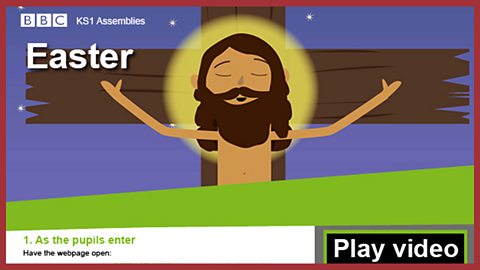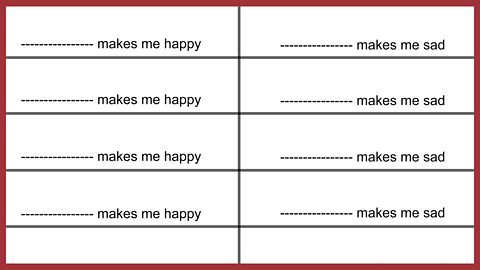In short...
Themes: Easter; Jesus’ death, resurrection and ascension; identifying which parts are happy and which sad; celebrations.
Summary: This assembly focuses on helping children identify the 'sad' and 'happy' parts of the Easter story and relate them to a promise Jesus made to his followers as he ascended into heaven. It starts with a ‚Äėcomplete the sentence‚Äô activity for adults - so you will need to put slips of paper onto adults‚Äô chairs with the question ‚Äė‚Ķmakes me happy‚Äô or ‚Äė‚Ķmakes me sad‚Äô.
Resources: print out the and distribute.

The video
The video contains the accounts of Jesus‚Äô death, resurrection and ascension to heaven. Although Jesus was very popular with many people, the authorities felt threatened by his teachings and crucified him - the most painful form of Roman execution. Christians call this day is ‚ÄėGood‚Äô Friday because they believe that this was part of God‚Äôs plan to rescue humankind.
Jesus rose from death three days later on Easter Day. Mary Magdalene was the first to see the risen Jesus and he appeared to many more of his followers during the days before his ascension into heaven, about 40 days after Easter.
Duration: 3' 50"
End of speech: '…to take his place in heaven with God.'
Video questions
- What are the two most important festivals celebrated by Christians? (Christmas - the celebration of Jesus' birth. Easter - the celebration of the end of Jesus's life and the start of his new life in heaven with God.)
- How did Jesus die? (He was put on a cross - crucified - on a hill above the city of Jerusalem. Jesus' death is called the crucifixion.)
- What name do Christians give to the day that Jesus died? (Good Friday. 'Good' because Christians believe Jesus' death is part of God's plan to rescue humankind.)
- How was Jesus' tomb made safe? (A great stone was rolled across the doorway.)
- Who does Mary Magdalene see in the garden? (Mary sees the risen Jesus - though she believes him to be a gardener at first.)
- Where did Jesus' followers see him for the last time? (On a mountain top - as he rose up into heaven (called the ascension).)

Key links
Download / print the assembly framework ready for use

Print out the activity slip and distribute beforehand


Suggested framework
1. Entry Play some music from ‚ÄėThe Messiah‚Äô by Handel - eg ‚ÄėSurely he hath borne our griefs‚Äô or ‚ÄėBehold the Lamb of God‚Äô or ‚ÄėI know that my Redeemer liveth‚Äô or the famous ‚ÄėHallelujah‚Äô chorus.
2. Introduction Ask the adults to share their completed sentences about things that make them happy or sad. This will help children to also join in the discussion, if time allows. Tell the children that the music they‚Äôve just heard is part of a longer piece which tells the entire story of the life of Jesus. Christians all over the world will soon be celebrating one of their most important festivals - Easter - which marks events at the end of Jesus‚Äô life on earth. We think of celebrating as a really happy thing, but the story of the first Easter has some sad parts too. Tell children that we‚Äôre going to watch some of that story now and, as they watch, to think about which parts would be ‚Äėhappy‚Äô and which parts ‚Äėsad'.
3. The video Play the video. A short introduction to Easter (29 seconds) leads into the account from the Bible of Jesus‚Äô death, burial and resurrection and continues into the ascension, which happens about 40 days after Easter. The duration is 3' 50" and ends with the words: ‚Äė‚Ķand then rose from the dead to take his place in heaven with God.‚Äô
4. After the video Ask children to share their ideas about the 'happy' and 'sad' parts of the video and to give the reasons why they think as they do. They could do this with a talking partner if this is something that’s familiar to children within the context of assembly.
5. Time to talk Lead a discussion using some or all of these questions. More time may need to be given outside of the assembly to deal with questions that the children may have. 1: Why do think the things Jesus said made some people angry? 2: What does it mean to ‚Äėforgive‚Äô someone? 3: How do you think Mary felt as she watched the stone being rolled across Jesus' tomb? 4: Why do you think Mary was so sad when she saw that Jesus‚Äô body had gone? Do you think she understood what the angel had told them? 5: Imagine that you are Mary telling all Jesus‚Äô friends what you have seen. What would you say to them? 6: What was the ‚Äėgood news‚Äô that Jesus wanted his friends to tell others about? 7: What do you think Jesus‚Äô friends thought when they saw him go up to heaven? 8: These stories often make people ask puzzling questions. What questions of your own do you have?
6. Opportunity to sing An opportunity to sing your chosen song. Suggestions from 91»»Ī¨ collections below.
7. Opportunity to reflect 'We‚Äôve heard today about the events that Christians remember at Easter‚Ķthe sad parts‚Ķand the happy parts‚Ķ In our lives we experience lots of different emotions, just as Jesus‚Äô friends did‚Ķand just as Jesus himself did‚Ķ When Jesus left his friends to be with God in heaven he said these words to them: ‚ÄėI will be with you, always and forever‚Ķ‚Äô Christians believe that Jesus says these words to them too, whether they are having happy or sad times‚Ķ I wonder what you think about these words‚Ķ?'
8. Opportunity for prayer 'Now I’m going to turn my thoughts into a prayer. Make the prayer your own if you would like to… Dear God, Thank you for the story we have heard today - the sad parts and the happy parts. We know that sad times are not always easy to bear. Whatever we are facing, we are glad to know that Jesus promised that he would be with us, always and forever. Amen.'

Suggested songs
Together - Vocal
- Work together, not alone,
Gather round and share a problem.
Work together, hand in hand,
Gather round and work things out.
Chorus
‚ÄėCos together, we can work it out together,
We can ride the stormy weather,
As long as we’re together we’re strong!
- There’s a setback, don’t despair,
Gather round and share your feelings.
Why just worry on your own?
Gather round and work things out.
Chorus
- If there’s trouble big or small,
Gather round and find an answer.
If you stumble there’s a friend,
Gather round and work things out.
Chorus
Together - Backing
- Work together, not alone,
Gather round and share a problem.
Work together, hand in hand,
Gather round and work things out.
Chorus
‚ÄėCos together, we can work it out together,
We can ride the stormy weather,
As long as we’re together we’re strong!
- There’s a setback, don’t despair,
Gather round and share your feelings.
Why just worry on your own?
Gather round and work things out.
Chorus
- If there’s trouble big or small,
Gather round and find an answer.
If you stumble there’s a friend,
Gather round and work things out.
Chorus
| Song | Collection | Significant words |
|---|---|---|
| 'God is watching over you' | All about our school, no 7 | A reminder of the Christian belief that God is with them in both good and bad times. The words are taken from Psalm 121. |

Related links
